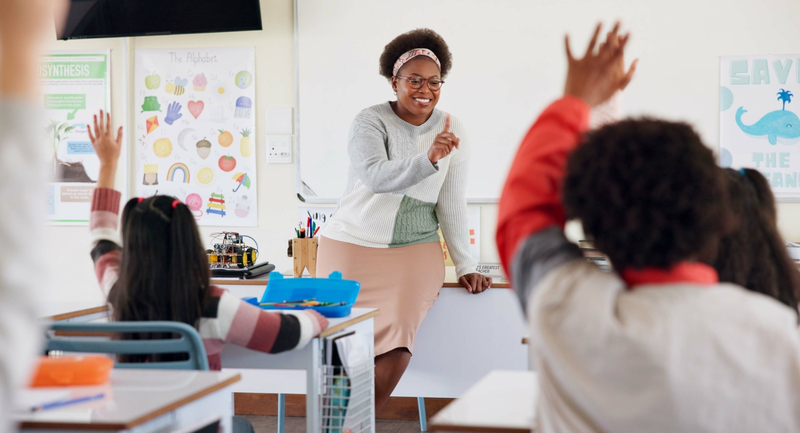Teachers and administrators are feeling exhausted and exasperated by the overwhelming number of students struggling to positively integrate and function within our school and classroom communities. What’s different? The state of students’ emotional well-being, stamina, and behavior.
Pandemic classrooms, cafeterias, athletic fields, and school hallways are seeing increasing displays of emotional dysregulation. Some students have become more combative and disruptive—physically fighting, screaming at staff or peers, swearing, running away, skipping school, throwing tantrums, flipping desks, self-harming, and hiding in the bathrooms. Other students have simply checked out and are disinterested, off-task, and unmotivated.
Schools cannot expect to employ a pre-pandemic approach to classroom management. Educators must consider where students currently are in terms of socialization, problem-solving, and coping skills—and respond accordingly.
To meet students’ evolving needs, I’ve developed a behavior management model that has worked successfully in both classrooms and administrative offices. I’ve coined the simple strategy ARC: Articulate, Reason, Commit. Unlike behavior management strategies that respond to poor student conduct, ARC is more proactive—it focuses on preserving lesson integrity and taking the guesswork out of expectations.
1. Articulate Everything
Difficult student behavior is often correlated with emotions such as fear, anxiety, anger, and insecurity. In many cases, educators can preempt an adverse emotional response from students by managing the experience or the lesson itself. That begins with clear, concise, consistent communication. Articulate everything! Out loud and often. That goes for school administrators as well as classroom teachers. Articulate your expectations, your vision, your values, the assignment—step-by-step, and all of the nuances that you could possibly foresee.
Imagine being in your student’s seat. What questions would you have about the expectations for the assignment and grading criteria? Ignorance is not bliss. Emotions like discomfort, uncertainty, and ambiguity are overwhelming—and can lead to outbursts or other acting out behaviors. The more students understand what is expected of them, the more likely they will feel comfortable with the lesson experience.
Articulate your expectations, your vision, your values, the assignment—step-by-step, and all of the nuances that you could possibly foresee.
Teresa Sullivan
2. Share Your Reasoning
The second part of the ARC strategy is reason. Students need to buy-in to the subject, the assignment, and the rationale behind why a particular lesson/experience is valuable, and why the parameters and expectations associated with the lesson are in place. This is particularly true of adolescent learners who have so many things competing for their attention, especially in the form of posts, clicks, and likes online. Lessons that aren’t immediately relevant will fall flat and lead to the inevitable “Why do we have to do this?” Younger students, on the other hand, are less apt to question the validity of an experience just as they are less likely to question the motive and expertise of a teacher or administrator.
Reasoning—when teachers share their thinking behind a pedagogical move—is also a relationship builder. Relational trust is a foundational element in all aspects of developing a strong and healthy school culture—a culture where students feel respected, known, and valued.
As LaMarr Moses wrote in an ASCD blog post:
Student trust in schools is heightened when they feel the adults in the building want what is best for them. They engage more freely in the learning process when they feel that teachers are invested in their educational outcomes and success. Students who do not trust their teachers may disengage from the learning process and create barriers which make developing healthy relationships with the adults in the building challenging.
Your students need to trust that your lessons have their best interests in mind. Genuine student engagement—not behavioral compliance, but real ownership of the lesson—is the single most important element to cognition. According to a Pearson report on student engagement, “a substantial body of research shows student-centered, active learning strategies increase student learning and achievement.” Establishing a clear purpose alleviates any lingering uncertainty and communicates to students that my teacher cares about this lesson and believes that it is important for me to understand.
3. Commit to Your Plan
One of the most common mistakes I see is what I call “classroom management by negotiation.” This is not the same as giving students choice and voice or personalizing/differentiating instruction—such strategies are carefully embedded in lesson planning. These are too important to be negotiated as ad hoc.
Teachers risk falling into a pattern of reaction and response to student-proposed negotiations at every turn: “Does it have to be 3 pages?” “Can I work by myself?” “Can I switch groups?” “Can we skip part 2?” “Can I just send this one text first?” “Do we really need to cite three sources?” “Can we read a different text?” “Can we read fewer chapters?” and so on and so on! If teachers lead classes by negotiation, students may become more engaged in the negotiating than the learning itself.
In the hundreds of classroom observations I’ve conducted as both a principal and administrative mentor, I have seen some amazing lessons deteriorate rapidly as teachers indulge in spontaneous negotiation with students. On the surface, negotiating seems like a reasonable strategy. However, once that door opens, it’s nearly impossible to close. Teachers need to exhibit certainty and confidence as the leaders of learning in their classrooms. If they allow classes to devolve into negotiating tables, they lower their standards because students will no longer trust in the academic and behavioral expectations that their teacher has articulated and reasoned.
As Jonathan Eckert explains, “It is no secret that most classroom management issues are eliminated when students are actively engaged in their learning.” And that’s just it! Engaging students in their learning requires a behavioral management approach that respects where students are both cognitively and emotionally. Educators must employ both cognitive and behavioral methodologies to positively impact student learning. The ARC behavioral management strategy may be just what teachers need to quell the pandemic storm.








